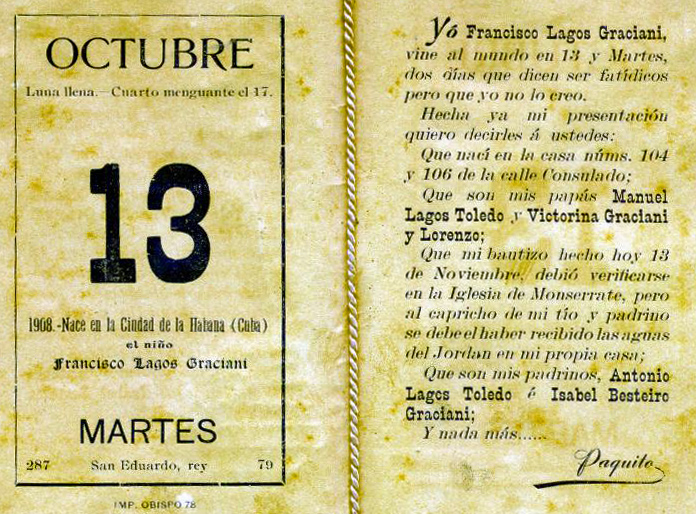
Birth announcement of Paquito Lagos Graciani, 1908
Oddly, it says that he should have been baptized at Monserrate but instead was baptized at home
Heide wakes
up sick to
her stomach and will remain in bed – except for a couple of hours
Friday – for
two days. She has opted not to
write her memoirs of these two days.
I believe Buzz and Toni went to the Hotel Florida
and got
online. Richard and Taylor walked
through old Havana and had a mojito at the bar at the Florida. It was so good that Richard filmed the
bartender in the act of making one: click on making
a
mojito
at the hotel Florida.
Chippie has volunteered to light a candle in a
Cuban church
for a friend. She hadn’t seen one
in Monserrate and was going to look for another church with candles. Given Raul’s friendship, however, she
decided to see if there was a way to do this there.
In addition, I decided to see if Paquito Lagos Graciani, the
son of the granduncle / great-grandmother marriage had been born and
died in the
parish of Monserrate, so the two of us head back to Monserrate.
Paquito and a candle. Francisco LAGOS GRACIANI, AKA Paquito, was the son of our granduncle Manuel Lagos, age 30, and our great-grandmother Victorina Graciani, age 46. When she found out her daughter was pregnant, so the family oral history goes, our great-great grandmother Joaquina Lorenzo shipped in from Spain to bring Victorina back to Spain to have her baby. But Victorina refused to leave and Paquito was born in Havana in October of 1908. He was both my mother’s uncle and first cousin. Had he lived and had children, I would have had a second cousin that was also, … oh, never mind.
In 1999, on my first visit to Cuba since the Revolution,
Merceditas
found an announcement of Paquito's birth at her father Miguel
Ángel
Besteiro's house:

Unfortunately, Paquito died at the age of one and
the line
never propagated. Still, Paquito’s
story has always intrigued me and, with my new-found friendship with
Raul, I reckoned
I’d see if I could track his history a little better.
But first Chippie wanted to make sure she lit her
candle. We hadn’t seen the bank of
candles normally found in Catholic churches in the US, so she asked
Raul if she
could light a candle. He said of
course, disappeared and came out with what looked like a little garden
pot. Do you have a candle? he
asked. Er, I thought you’d have
one, she said. Ah, replied Raul, …
but this is Cuba.
But I can get you one that’s already partly used,
he
added. And he did, and she lit the
candle, which was then placed in a spot of honor in front of the
church’s
nativity scene at the altar.
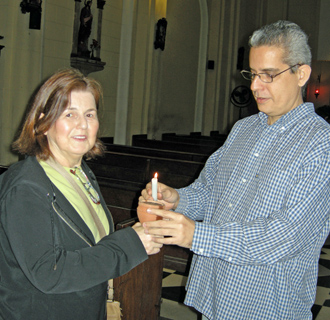
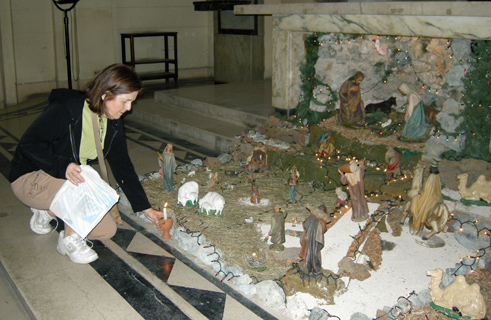
Then we got to looking for Paquito’s baptismal and
death
certificates, and found both! He was born, on October 13, 1908 and died
on
December 12, 1909; we already knew these dates. The cause of death was
unclear (both the writing and
the
fact that it’s a term that’s probably unused now), and Raul said he’d
look for
the expediente and see if we could figure it out from that.
Francisco
Lagos
Graciani
baptismal certificate p1
Francisco
Lagos
Graciani
baptismal
certificate
p2
Francisco
Lagos
Graciani
death certificate
Victorina’s death record? I was
on a roll, and figured, what the hell, maybe my great-grandmother
Victorina was
living in this parish when she died. I know roughly where the house
was, and when I
tell Raul
he says, yes, for sure she was in this parish. So we look her up (I
know she
died in 1931) but don’t find her.
Raul is puzzled but after reflecting a bit tells me to wait a
minute. He comes out with a book
that details the history of all parish archives in Cuba and finds out
that
Nuestra Señora del Carmen, a church on the other end of Centro
Habana, began
keeping records in 1923 and that Victorina was probably resident in
that parish
at the time of her death. I make a
mental note to visit that church before I leave town.
We head back to the hotel and – possibly – have
lunch. Some memories – like midday food –
have
faded by the time I write this. I check in with Heide and determine
that she’s
still ill and not ready to travel.
Enrique and Mercy and family live in Cerro, which,
like
Santos Suárez, is an area of Havana virtually unknown to
tourists (and,
apparently, taxi drivers). Our cab driver got terribly lost (it
apparently
was due
to the fact that “Avenida de la Independencia” is better known to most
Habaneros by its “old” name, Boyeros; the cabbie had no idea that the
two were
equivalent).
But we got there.
And as a bonus, a bunch of goats crossed the road just before we
arrived. Taylor leaped out of the cab and took a zillion photos (adding
to the
collection of “small animals of Cuba” on which she and Toni
collaborated).

Sheila is a cute little kid and sang a song for
us
before we
left. It was a very nice visit
and, as we got in the cab to leave, Enrique donated the rest of the
bottle of
rum to us.
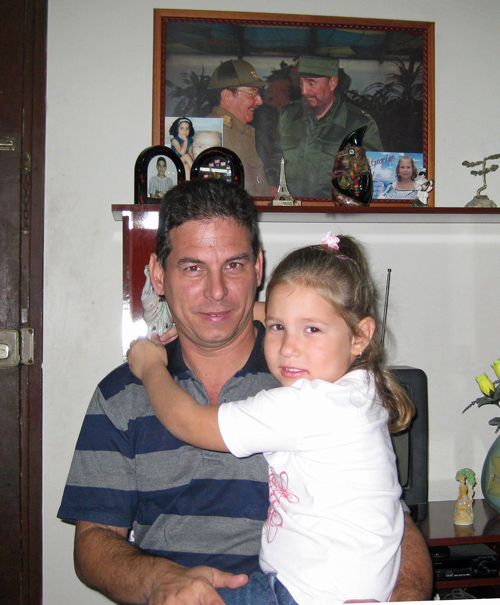
We had to leave to have dinner with Alicia and Roxana, but we took a
quick group picture before we left what was a wonderful visit.
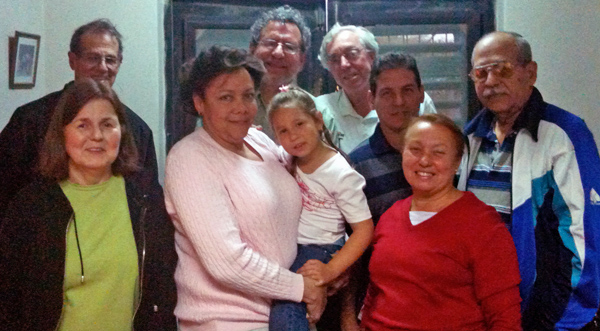
A visit with Alicia and Roxana. We got
back to the hotel in time to gather a few things and take off for our
next
family visit.
We’ve been bringing a few things to all our relatives
and this is
no exception. We meet Alicia, the
daughter of Manolita Graciani, niece of our great-grandmother
Victorina,
Alicia’s daughter Roxana, and Roxana’s son Jonathan.
Jonathan is unable to join us, as it’s his girlfriend’s
mother’s birthday (or her grandmother’s birthday, or … but you get the
picture), he's committed for the evening.
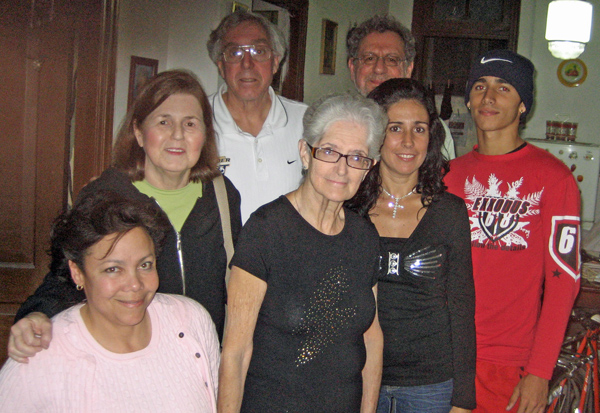
At Alicia's: from left, Toni, Chip,
Buzz, Alicia, Richard, Roxana & Jonathan
After we make our presentation, we
jump in the cab
(the same
cabby has been our driver all day) and head to a place that he
recommends
(Alicia and Roxana have no recommendations). Unfortunately,
we
find
ourselves
in
a
place
not
frequented
by
Cubans.
The place isn’t terrible, just mediocre.
It’s called el Guajirito (country boy),
and it’s next to the RR station in Old Havana. The
waitresses
are
barefoot
and
dressed
in
cowboy
hats,
which
presumably
makes
them
country
girls,
but
many are blond and they’re all dressed in
short
skirts. I just don’t know about
that. Chippie likened it to a Cuban Cowboy Hooters.
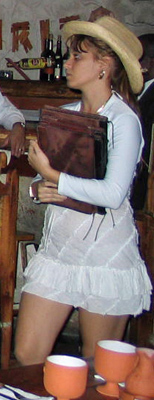
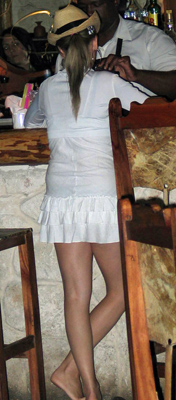
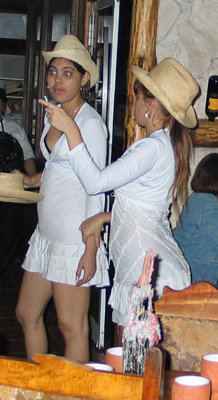
Some
of
the
servers
at
El
Guajirito
Anyway, my meal was OK. Richard
–
I found out later – had an excellent picadillo,
which I hadn’t noticed on the menu.
And we had pleasant and informative conversations with both
Alicia and
Roxana who, of all our relatives, seem to be the ones trying to live
entirely
on virtually nonexistent salaries/pensions.
If I were to guess, between Roxana's salary and Alicia's pension they
probably earn about $20 a month (and Jonathan is still in
school). Everything
that
wasn’t
eaten
went
home with them.
Once you’re away from the tourist hotels, getting
a cab is
kind of a crapshoot in Havana, and often you’re just taking a ride in a
private
car. We put Alicia and Roxana in
such a “cab,” and after they got in a second guy got in the front seat
and they
took off. We were somewhat
concerned. We walked back through
the dark streets of Havana to our hotel, and I immediately called to
make sure
they’d gotten back OK. Yes, says
Roxana, I was a little concerned myself, but everything was fine.
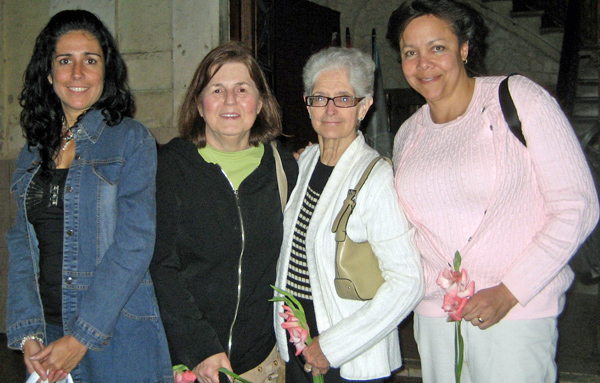
Chippie got a fabulous group of shots of the sunrise from
her room.
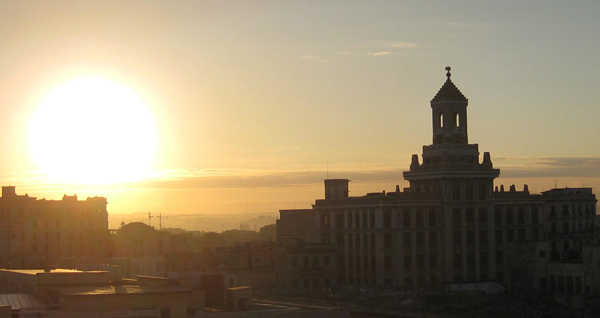
Heide still didn’t feel well, but well enough to
go to
market with Chippie; first they stopped at the Hotel Florida to do some
email
from José Antonio’s Cyber Cafe. Then they walked down Obispo to
a souvenir
market. Near the Plaza de Armas
they saw a group of stilt walkers, and following that, Heide took
Chippie to
the Plaza de la Catedral, Havana’s Cathedral.
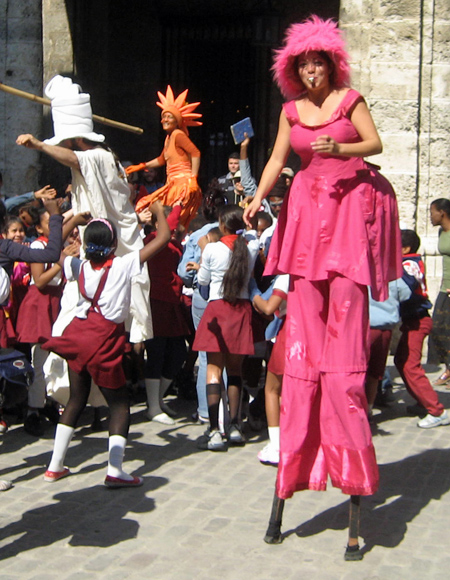
One
minute
video
of stiltwalkers
Two more photos the one of the other group took follow. One is of the omnipresent gaudily dressed santeras, who tell fortunes, but for tourists, mostly pose for pesos smoking a cigar. The second is of a local kid dressed, for some reason, in a rugby union T-shirt of unknown origin.
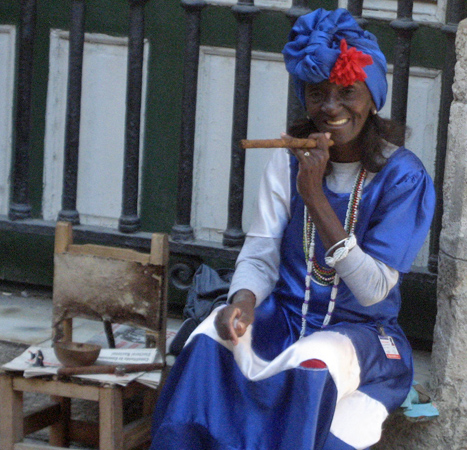
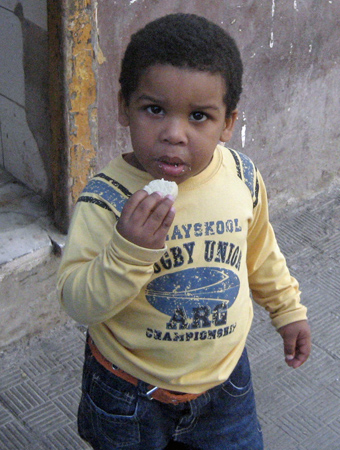
Left: Santera with Cigar; Right: Boy
with Rugby Union T-shirt (huh?)
I’m not sure what Buzz and Toni did, but Richard
and Taylor
had their own adventure. They took a bici-taxi ride and went to a
paladar (a
legal home restaurant detailed in my first Havana report) where they
had great
chicken and “moros y cristianos.” Taylor was shocked by an eagle in a
cage. On the way back, they had to
leave the bici-taxi because he was out of the zone in which he was
allowed to
operate.
I, on the other hand, wanted to see the church
where my
mother was baptized and headed off alone on a new adventure.
Mother’s Baptism: Calle Salud and the Church
of La
Caridad.
It has been my experience, from examining records both in
Spain and Italy, that people were baptized very close to their
birthdate; the
further back in time we go, from what I’ve seen, the closer the baptism
was to
the actual birth, often on the same day.
Even contemporary with my mother, baptisms would take place
within a few
days of the birth; after all, the poor child was risking limbo if she
died
before baptism.
My mother, however - María del Carmen LAGOS BESTEIRO,
born on October 5, 1910, was
not
baptized until March 19, 1911.
Why? I have no idea. I know
I have a later record copied from the baptism certificate because I
reference
it in my database, but I want to find the church, find the original,
and
reconnect.
My mother was baptized in the Church of Guadalupe;
its name,
however, was changed to Nuestra Señora de la Caridad shortly
after her
birth. It is on the corner of
Salud and Manrique, perhaps a 15-minute walk from the hotel. The walk
takes me
past the Capitolio and the entrance to the Barrio Chino.
Right at the Chinatown entrance, the
last time I was in Cuba, was the Hotel New York, a Cubans-only hotel in
which
Uncle Manuel lived the last years of his life. This
time,
however,
the
building
(kind
of)
remains,
but
it
is
no
longer
whole
and
no
longer in use.
There is a park just past the corner and Salud
begins
there. I walk down Salud a few
blocks and find the Church. I walk
in and am impressed by its beauty.
I see a nun at the entrance and tell here what I am looking for. She disappears. When she returns, she
tells me to walk around the church and enter around the back into the
church
office; it ends up being on the next street. When I get there I sit in
a little
waiting area and soon I am met by a priest who seems to be the rector
of the
parish (I am so focused by my task I forget to ask his name, but he’s
clearly
the boss.)
Because it's a big building and because it's impossible to
capture it all in one shot, here is a little video of the Iglesia
de
La
Caridad in its environment. Some photos of the church follow.
I tell him what I am looking for and he has
someone dig out
the appropriate book. He is not able to find the document from the page
indicated on the index, but I remembered the March 19 date and we paged
through
by date and found it.
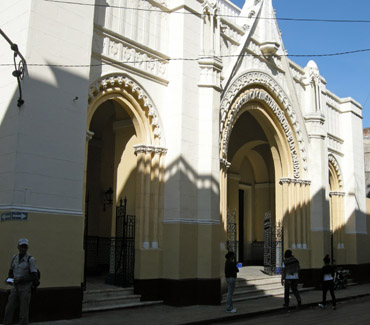
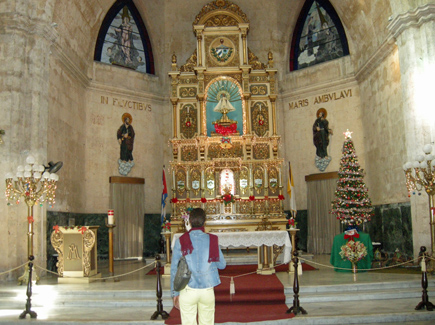
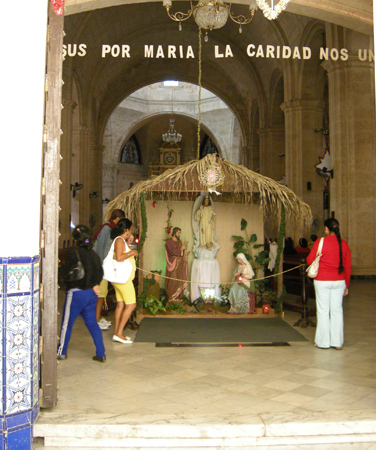
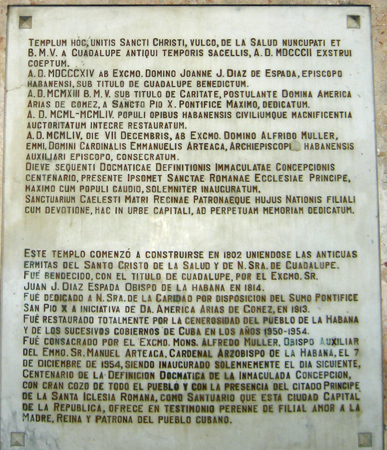
Left: Nativity Scene, we were still in Christmas Season
Right: History of
the church, in Latin and Spanish
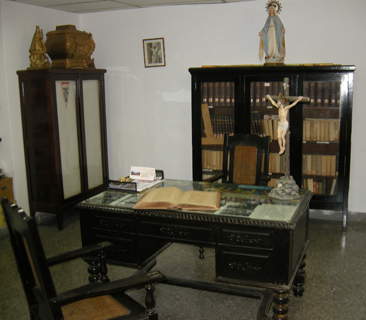
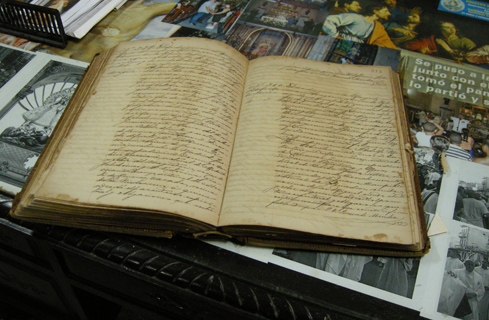
The Rectory of Iglesia de La Caridad,
and my mother's baptismal certificate in the original volume
Baptismal
Certificate - Carmen Lagos - p 1
Baptismal
Certificate
-
Carmen Lagos - p 2
[Note
of March 5- this entire paragraph has been modified today as a result
of information gathered on March 2. There is no clue as to why
mother’s baptism was
delayed by
nearly 6 months, but I do see why she was baptized at La Caridad.
We
had thought she was born at the current Galiano 125, which is only a
couple of blocks from Monserrate. We now know she was born at the
site
of the current Galiano, 509, further up the road. In addition,
the
site of her baptism is at Calle Salud 13, which definitely falls within
the parish limits of the church of La Caridad (when she was born it was
the church of Guadalupe).]
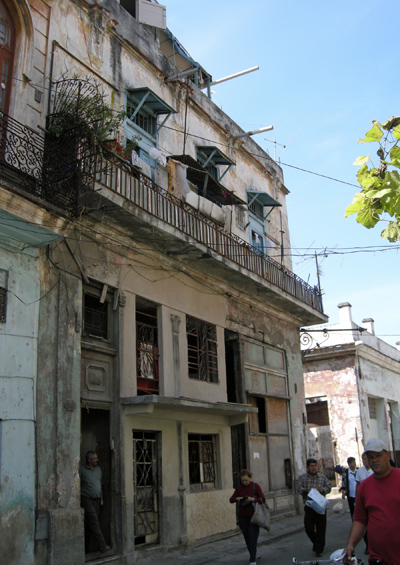
It was a beautiful, beautiful day, the only one we
had. It
was probably 70 degrees and I was actually appropriately dressed in
short
sleeves. I looked on my map for the corner where Raul had told me
Nuestra
Señora del Carmen was located (Neptuno & Infanta) and it
looked like it was
about 2 miles away. Sounds good, I
thought, and set my sights there.
I headed West down Salud and snaked my way until I
made it
to the church. I got there about
12:15 PM and the sign said “Parroquia Ntra. Sra. del Carmen. Horarios
8:30 –
12.m y 3:00 – 6:30.pm.” In other words, I’d missed them.
I started heading back thinking of when
I could return when I was approached by two men who started chatting to
me and
asking me if I wanted to see a street where all the buildings were
painted
strangely. I knew these were
“jineteros,” hustlers, but figured, what the hell, this is time I
figured I’d
spend in the church and that was no longer possible.
[Note
- I could not connect with this church on this trip, but during my
wrap-up info gathering on March 2, following the Atlantis rugby trip to
Havana, I was able to get Victorina's death certificate. She
obviously
was not known to the person who filled it out, as they put down
VictorianO Guciano, hijO de ... sigh ...]
Here is the death
certificate, and the picture below is of the house where she was
living when she died.
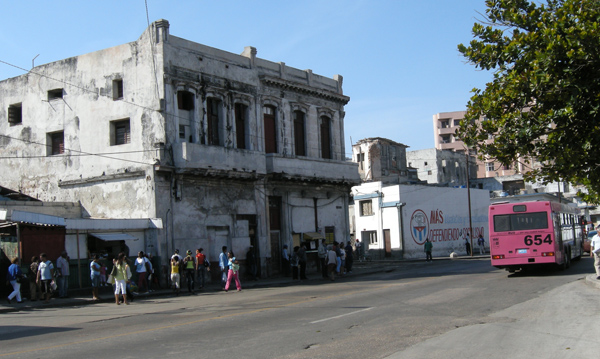
Callejón Hamel and the friendly
jineteros.
Callejón Hamel (oddly, the H is pronounced) is a street
off the beaten
path in the neighborhood where the church of Carmen is located. The streets are painted with what seems
to be African art with Afro-Cuban themes and it is quite an intriguing
scene.
There is a relation to the Afro-Cuban religion of santería, but
I don’t quite
understand the connection from our discussion. It is a project of the
painter
Salvador González Escalona. We
walk through the place, into a little museum, and I am told that if I
return
Sunday at noon there will be music and dancing.
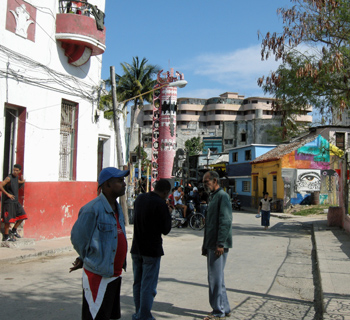
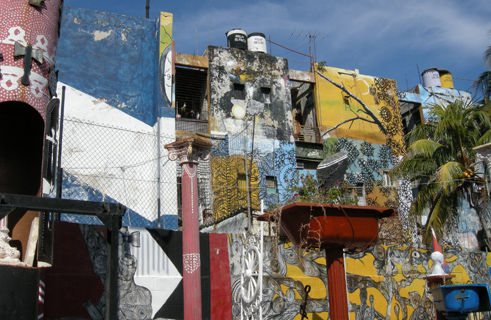
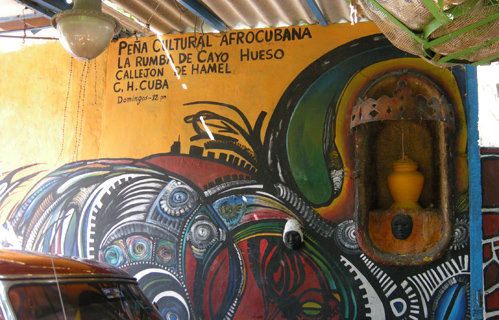
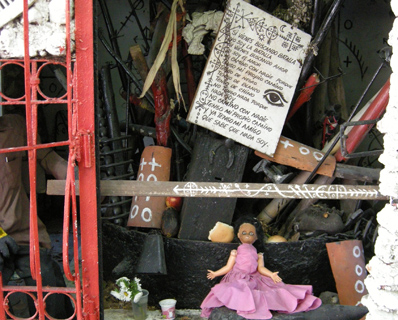
Callejón Hamel: some details
of the area
Throughout this visit I am constantly being asked
if I would
like to buy a) paintings, b) CDs, c) drinks, etc., and I constantly say
no. When we leave, however, they
pull the trump card: would I like to buy milk for their family? At any rate, milk is $6 for a pack of powdered
milk – well that’s the story anyway – and I spring.
I reckon as soon as I turn my back they return the milk,
leave a buck for the woman at the store and pocket the rest, but … what
the
hell, it was a really neat discovery and maybe I’ll try to get our
group to
return Sunday. (After getting home
and checking the web, I discover it’s a pretty well-known and respected
place. And based on youtube, the
music is good as well. And what would a tour of Havana be without a
jinetero
encounter, anyway.)
Cuban Rugby. When we
finally split, it’s a little
after 1 PM, and I’m wondering if I can make it back in time walking for
my 2 PM
appointment with Chukin Chao, the head of rugby in Cuba.
We are to discuss a tourney in which my
invitational team Atlantis will participate in late February.

When I get back to the hotel Heide and Chippie are
having
lunch following their pleasant trip through Old Havana.
(For Heide, however, this will be a
short-lived recovery; she heads back to bed afterward and doesn’t get
up till
Saturday morning.)
At 2 PM Chukin, Juan Carlos and Alexis show up;
they had all
been part of the Cuban team Atlantis had played on our first two visits
to Cuba
in 2000 and 2001. We had a
sandwich and a beer, and they covered the tab, which both surprised and
embarrassed me. And they covered
Heide and Chip’s table. We
discussed the upcoming tournament and they took me for a ride to the
field (it
was the same one on which we had played previously) and the tournament
hotel,
the Occidental Miramar, located on Cuba’s prestigious 5th
Avenue. It was an amazing place,
certainly for Cuba, which is not renowned for its opulence, and better
than
probably 99% of places I’ve stayed at on rugby tours.
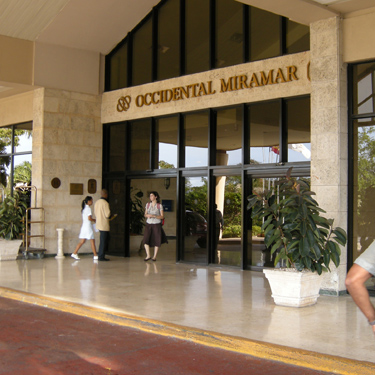
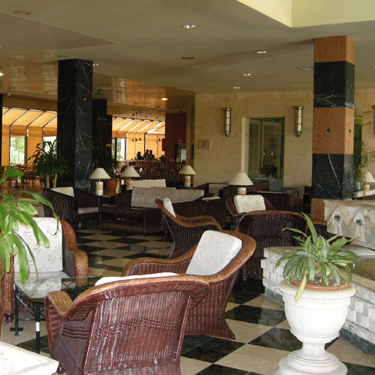
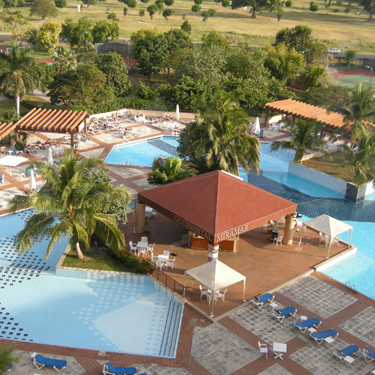
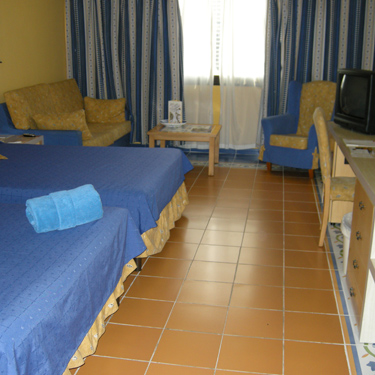
Hotel Occidental Miramar - Four Views
We also stopped by the field on which we'll play: it's the
same one Atlantis played on in 2000 and 2001.
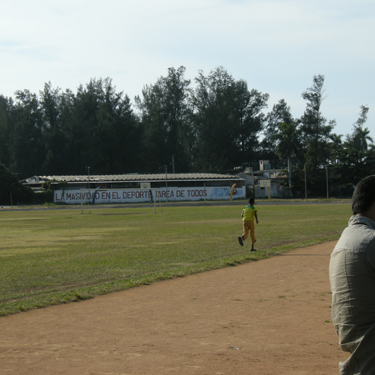
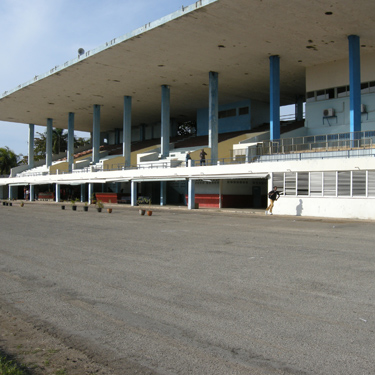
They are hoping to get teams from the US (we are
waiting for
a license from Treasury and at this point I am pretty confident we will
be able
to attend, but … time will tell), Canada, Mexico, France, West Indies,
Peru, …
in short, it should be a great time.
I’ve collected most photos that people took on
this tour,
and based on them it appears that Toni and Taylor spent much of the
week photographing dogs and cats of Cuba.
[note: LINK TO
COLLECTION OF ANIMAL PIX]
Raul returns.
Tonight we’ve got an appointment with José Antonio and Magda for
paella at the
Hostal Valencia. It’s getting to
be time, and I check the lobby for family members. I find Richard and
Taylor
talking to Raul Ballate, the Archivist of the Monserrate Church … he
has found
the expediente for Paquito’s death certificate and has brought it to
the hotel for
me.
One
thing both Chippie, and now Richard, have noted, which I guess I knew
but
never thought about, was that Paquito died 8 days before Maina and
Papa's wedding. More than likely, they both note, it was
Victorina's
being in mourning for her youngest son that prevented her from
attending her older daughter's wedding. Yeah, I think, that does
put a
new spin on the story. It is yet another reminder of why I smile when
people ask me - which they have - what could possibly be interesting
about so many documents about dead people... I think, who needs novels
when our own history
holds so many mysteries?
Raul and I had also discussed the discovery, in
1999, that
Uncle Manuel’s bones had been “desecrated” (this discovery, detailed in
my 1999
article “Your Man in Havana,” was pointed out to me by the cemetery
employee
that found them) by, I was told, practitioners of santería. He has also found a book on syncretic
religions in Cuba (e.g. santería), (syncretism = the attempt to
reconcile
disparate or concrete beliefs), religions that combine Catholicism with
African
beliefs and rituals. Raul told me
it was not the santeras but rather the monte paleros that were
responsible for
this desecration and brought this book for me to read.
He’s inscribed the book to me, “Luis
Signes.” For an archivist, Raul does not have the greatest memory for
names. What a great guy,
though. While Richard and I are
engaging him in conversation, Taylor has brought down a pack of
clothing she
gives Raul, who promises to distribute it to the needy in his parish.
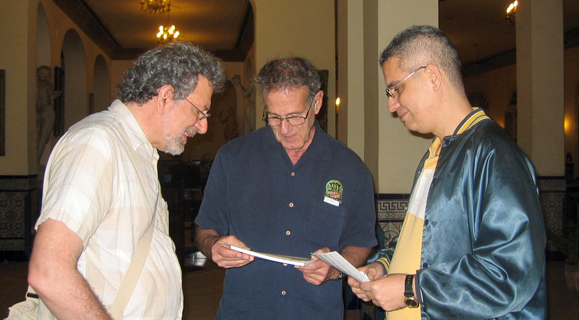
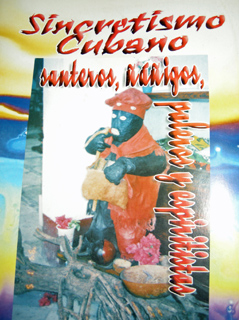
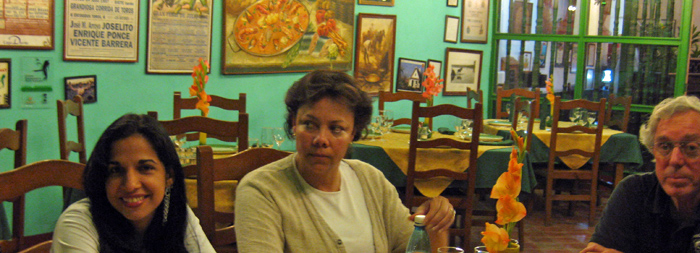
At the Hostal Valencia: Magda, Toni, Buzz
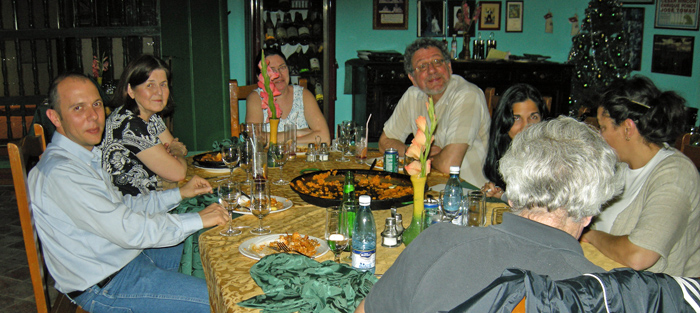
Enjoying the food at the Hostal
Valencia
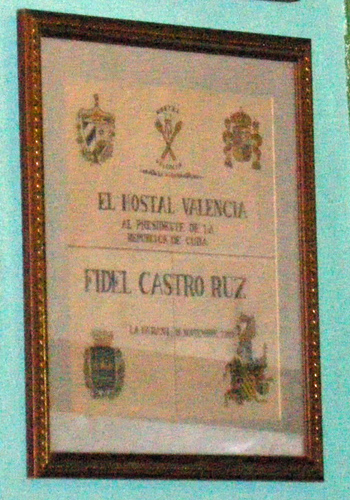
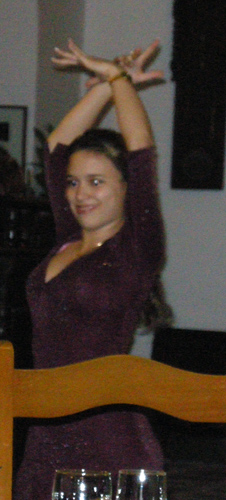
Left: Fidel was here
Right: flamenco dancer
La Mina. I have great
memories of La Mina, an
outdoor restaurant/bar that features traditional Cuban music every
night. When we arrive a sextet – trumpet,
guitar, mandolin, bass, timbales and guiro (gourd) – is playing and the
music
is excellent.
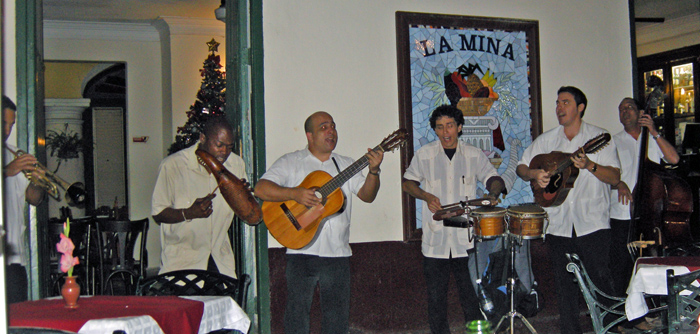
The Sextet at La Mina that we enjoyed so much
As we’re paying the bill, a duo walking down the
street
stops by and starts singing traditional Cuban romantic songs, boleros. They play three and we are (well, I am)
overwhelmed by their beauty. We
get them to play one more, which is an original composition by the lead
guitar
player. At this point a third
person, playing the maracas, joins them and I ask Chippie to film this
song as
well, so we have an example of both groups. Flip video is a good thing.
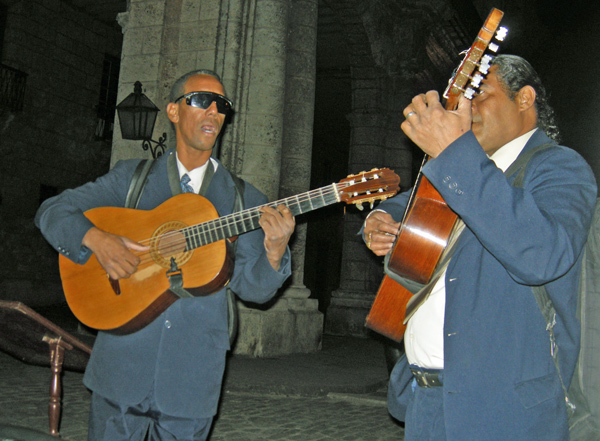
Click here for
video performance of this duo with song that
starts Cuantas
veces ...
Actually it’s probably also a good thing that La
Mina closes
down early; we’re all tired. Well, we thought we were till we stop in
at Bar
Capone (Richard’s room) for a few añejos. First we say good
night to Buzz and
Toni who have to leave early in the morning. Much though we love the
family,
none of the rest of us is in the mood to get up at 6 to say goodbye.